Following their glorious run in the 2018 World Cup that they hosted, Russia will be looking to replicate or even improve on that success in the upcoming Euros. Stanislav Cherchesov has warranted his contract extension which will see him take charge of the team for yet another big event but with a squad that does scream for a major overhaul, chasing success may turn into something that’s easier said than done.
The former Spartak Moscow and Dynamo Moscow coach is, however, the first Russian manager to take the national team into the knockout stages of a major tournament since the collapse of the USSR. Of course, there was Guus Hiddink before him who achieved the same in 2008 after beating Spain but he is not Russian, making Cherchesov’s achievement in 2018 that much more impressive.
Still, Russia feel like a team that’s trying to live on the glory of the World Cup and an ageing squad that has quality but is over-reliant on their veteran stars. Their last set of games suggest they are in a mixed form, tallying some decent results but at the same time, faltering against opposition who are not afraid to control the proceedings. The defeat at the hands of Slovakia certainly stings a lot and so does the 5-0 collapse against Serbia and the 3-2 fall against Turkey. However, wins against Malta and Slovenia do suggest there is still hope Russia can pull something out of their bag once push comes to shove.
Cherchesov can also not be too happy with a string of draws in the Nations League and the friendly against Moldova at the end of 2020 so some improvements will be necessary heading into the upcoming Euros.
Russia will still play two friendlies before starting their group stage journey and locking horns with Belgium – who have Real Madrid, Manchester City, Inter Milan and Tottenham Hotspur stars – Denmark and Finland, three strong teams that can make their lives very difficult. For that reason, warm ups against Poland and Bulgaria must be used to fine-tune what’s necessary and make the final tweaks to sharpen their edges.
For now, however, they seem like a mixed bag that will need the help from their established stars to push them in the right direction.
THE SQUAD
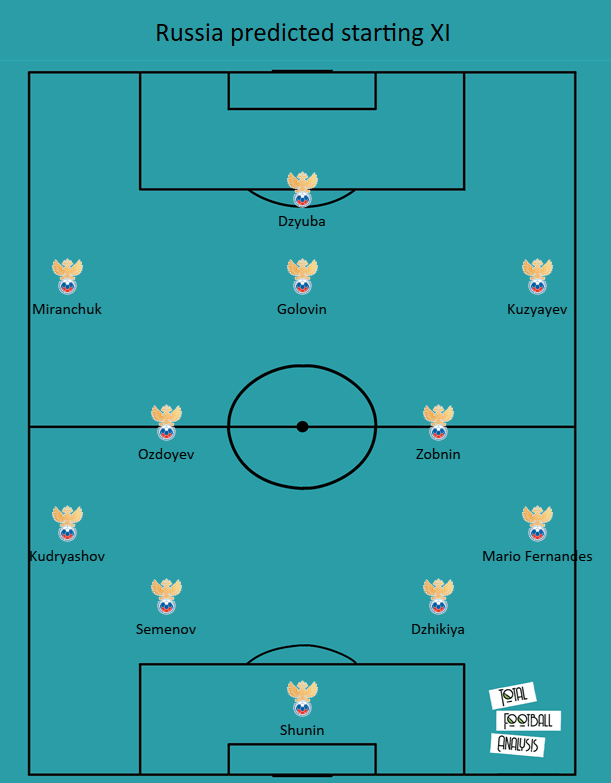
As we’ll see at the beginning of this tactical analysis, while Russia’s squad has some established names, it is far from a well-balanced set of players. We can expect them to line up in their usual 4-2-3-1 structure with two midfielders serving as extra protection behind the backline. That said, we have seen some experimentation from Cherchesov who isn’t afraid to deploy a back five if necessary.
The team they’re taking to the Euros still has a lot of quality and with players like Artem Dzyuba, Mário Fernandes and their young star Aleksandr Golovin, they can go toe to toe with some of Europe’s best. The depth in the squad, however, is not that great. Looking beyond the strongest 11, it does feel Cherchesov’s options are quite limited to say the least. The goalkeeper situation is especially concerning since despite Anton Shunin’s quality, there is no one in the team with great international level experience.
Similarly, as the scout report will show, in midfield and apart from Golovin, the team is completely bereft of technical quality, which makes getting the ball to Dzyuba that much more difficult. Speaking of the side’s captain, he will once again be their biggest source of goals, having also bagged nine in the Euro qualifiers, topping the charts for the team.
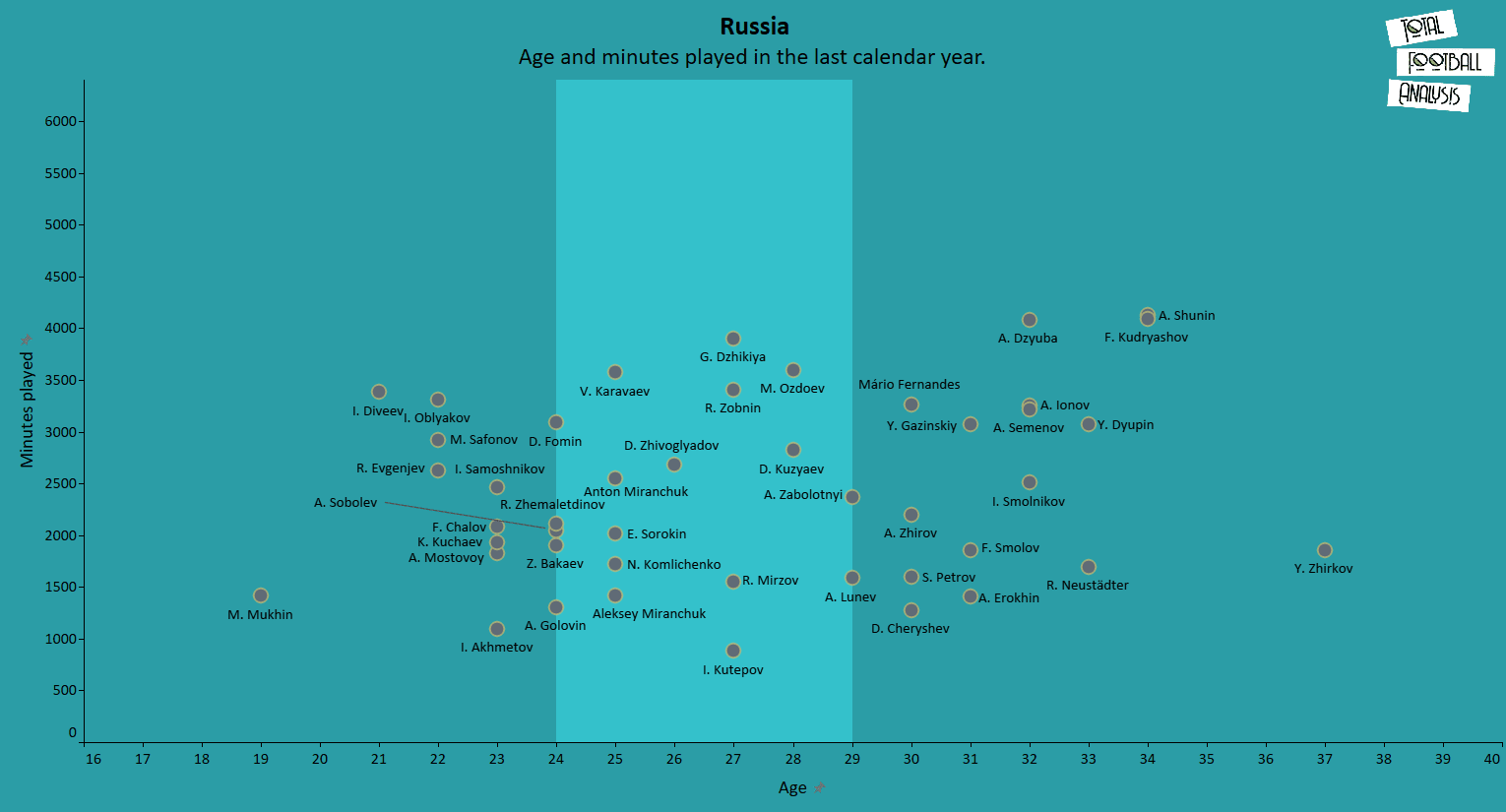
But looking at the age graph of the squad, it highlights Russia’s need to overhaul their team even more. A lot of their key figures with the exception of Golovin are in their late prime or already in experienced years, meaning sooner rather than later, there’ll be a generational shift.
Russia need their young players to step up, take up the mantle and lead the next iteration of the team to glory. However, at this point in time and looking ahead to the Euros, it seems the veterans could once again take the spotlight, for better or worse.
ATTACKING PHASE
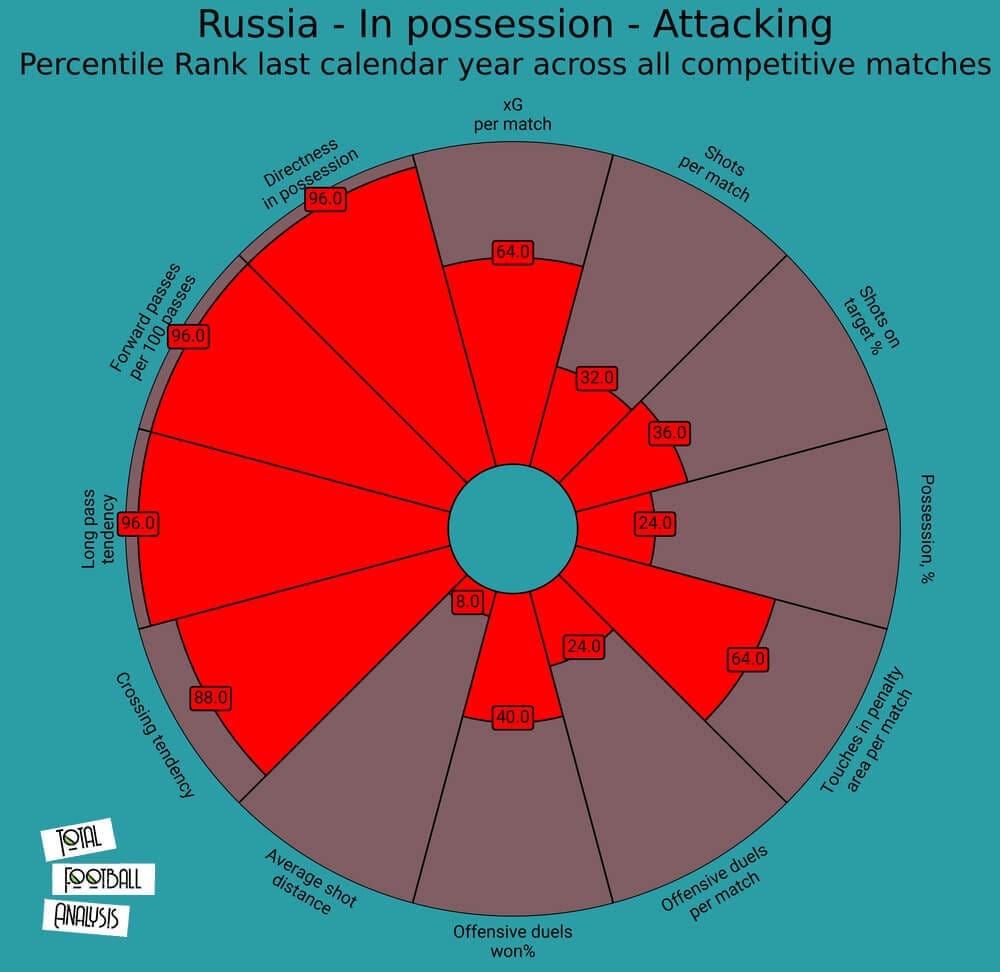
Looking at Russia’s in possession chart, we can immediately see their general style of play. Cherchesov’s team is very direct, focusing on long balls forward into their target man up front. The numbers confirm that thesis as they are in the top 4% in all three of long pass tendency, forward passes and directness in possession.
Russia are not a team that will recycle the ball for too long nor will they aim to systematically dismantle opposition through positional play. The backline will clear the ball towards Dzyuba who is often dropping slightly deeper to hold up play and then it’s spread wide for a crossing opportunity. Again, that is confirmed by their 88th percentile ranking in crossing tendency and a very low 24th percentile in possession percentage. Russia will actively avoid having prolonged spells of possession despite potentially having the quality to do so, albeit from just a couple of clear sources.
Their shooting and xG (expected goals) values are, however, very low and that’s where they might encounter big problems. Despite being in the upper half in regards to the xG percentile rankings, both their shots per game and shots on target are not good enough. When you factor in the average but decent touches in the box per game and a very short average shot distance, it seems they struggle to create often enough.
This could be down to a couple of problems. The first one, of course, is the lack of a different approach. Cherchesov can be a very stubborn man, often set in his ways and unable to (or unwilling to) come up with different solutions despite experimenting with the lineup every now and then. Yes, Russia’s direct route has served them well in the past but the lack of a plan B can and will eventually hurt their progress. The second reason is simply the fact that apart from Dzyuba, and potentially young forces like Fyodor Smolov and Aleksandr Sobolev, Russia don’t have a very big pool of players who come that close to his output.
Denis Cheryshev can and should offer some presence from the wings but his involvement will largely depend on Cherchesov’s opinion as he is not always a nailed-on starter. We can expect Dzyuba to chip in with goals since that’s what he does best but if teams find ways to shut him down and limit the midfield’s already struggling production and creativity, Russia could be in a world of trouble.
Finally, when taking a look at their offensive duels and offensive duels won percentile rankings, it’s also quite obvious that they’re not doing well in those departments. This is closely connected with the lack of a creative output as their players often struggle at securing an advantage in 1v1 situations and creating ‘something out of nothing’. Of course, there are exceptions to this in Golovin and Dzyuba but apart from them, there are no players capable of those magical moments of individual brilliance that can shift the tide of the whole game.
A fairly usual approach, as we’ve alluded to earlier, would be the backline feeding balls into their key targets, Golovin and Dzyuba directly. Cherchesov doesn’t really encourage Russia to play out from the back but they do have the option to do so if the opportunity arises. In such a scenario, Aleksandr Zhirov and Andrei Semenov are one of their most progressive options in the backline.
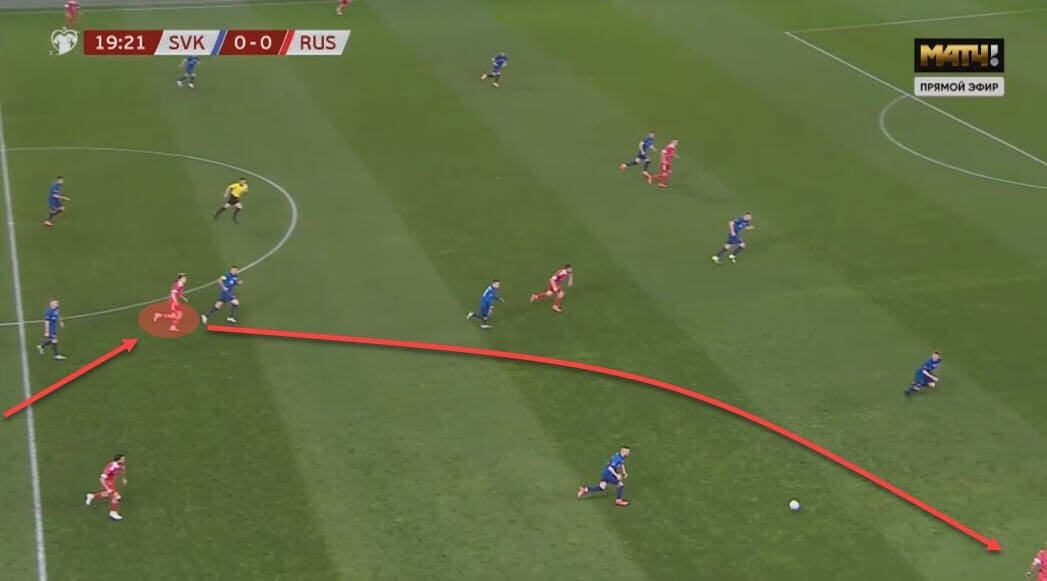
You can see how the ball is usually played into the midfield, looking for Golovin who has the technical quality to play quick and penetrating passes further up the pitch. The young midfielder will aim to progress the ball and speed up the tempo, always looking for a positive play rather than sending the ball backwards. This is where the big brunt of Russia’s creativity comes from and also where their success often lies in.
If Golovin gets time and space on the ball, he can and will make things happen for the team. In the previous example, we saw him shift possession wide with a single touch, enabling Russia to advance through the flanks and get into those desired crossing opportunities. Another way to progress is via an even more direct route.
Cherchesov’s men will often look for Dzyuba, who likes to drop slightly deeper to link up with the midfield or receive a pass directly from the backline. This is a tool they use to bypass the opposition’s press as well as orchestrate attacks. You can see Dzyuba do exactly that in the following example.
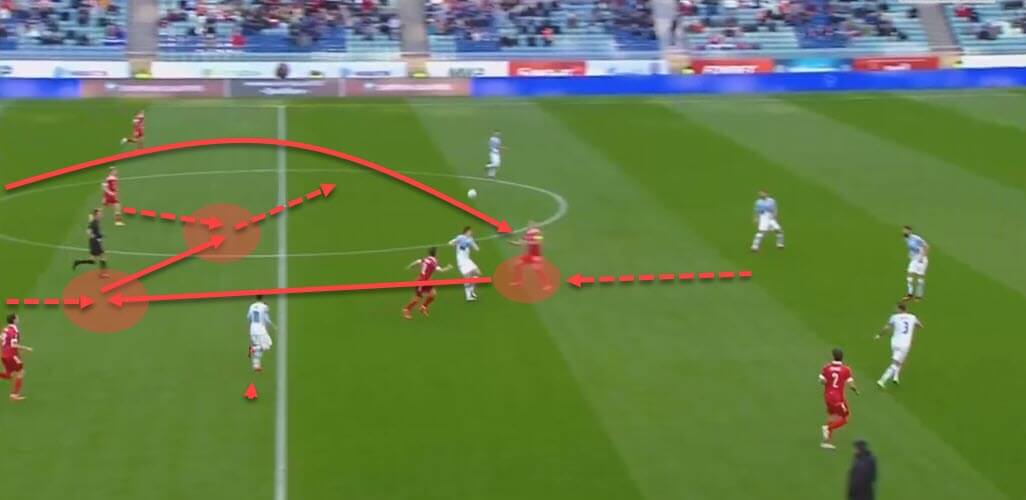
He receives a long ball from the backline, immediately lays it off for the supporting player and it quickly goes to Golovin who can run with it towards the final third. Such a sequence is something we’re used to seeing quite a lot and will undoubtedly be a part of Russia’s arsenal in the upcoming tournament.
Even though they don’t always have loads of possession, they can recycle it fairly well. In the last calendar year, Russia have tallied just over 50% possession on average but will still gladly surrender it against high-tier opposition. This is a shame as it sometimes feels they have the squad to battle for the supremacy of the ball, even though that carries a certain risk in itself.
DEFENSIVE PHASE
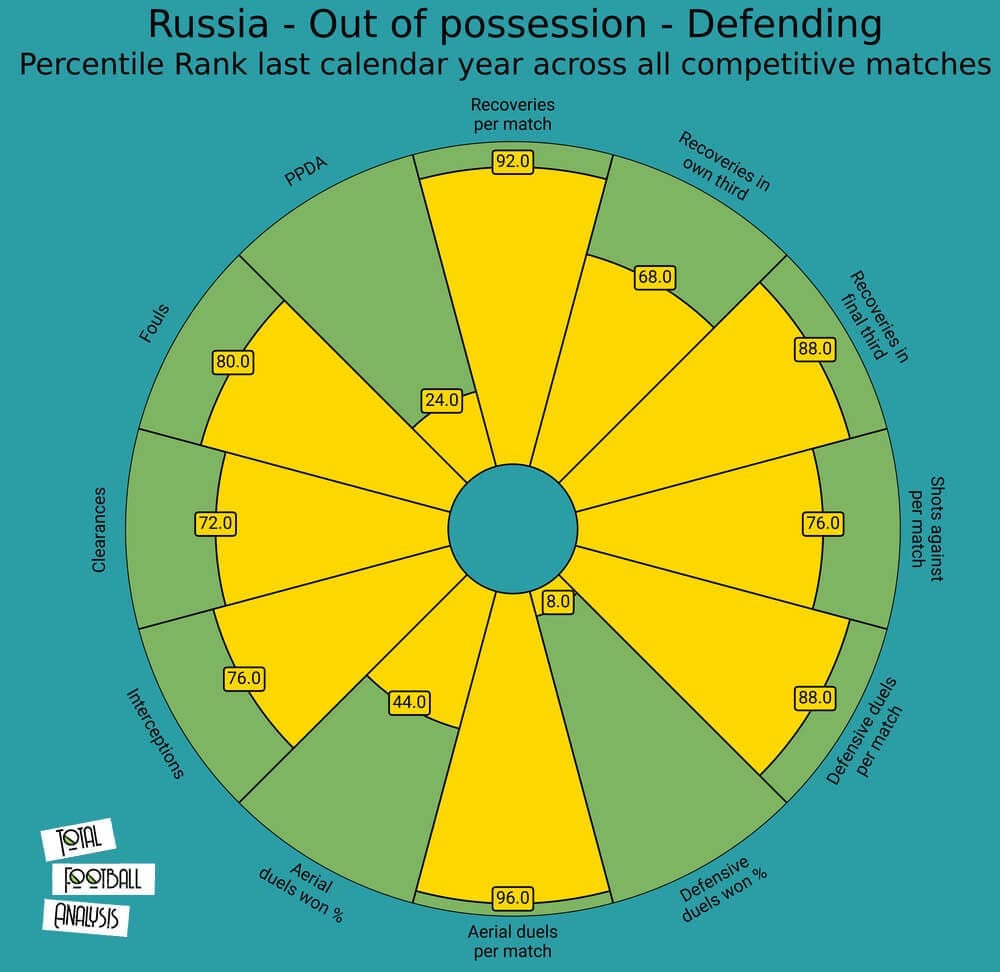
Similarly to the attacking phase, Russia out of possession also have a clear identity, which is an encouraging sign overall. They will aim to suffocate the opposition in the final third, often contesting the ball high up the pitch and not letting the other team have time and space in possession. This is confirmed by a rather low PPDA (passes allowed per defensive action) percentile ranking which indicates a high dose of aggression in the defensive phase.
That fact goes hand in hand with one of the highest percentile rankings in recoveries in the final third, suggesting once more Russia will recover the ball close to the opposition’s goal, making their transitions that much deadlier. Even when the initial pressing and counter-pressing is broken, they are still aggressive and will make a lot of interceptions and even own third recoveries, as indicated in the defensive chart.
But considering they make a lot of fouls as well, seeing how they rank in the top 20% in sheer volume, we can conclude their press is not always a perfect tool to set up transitions into the opposition box. However, it is effective at stopping the other team from advancing and resetting the play so Russia can assume their organised defensive structure. In those scenarios, they are not afraid to soak up the pressure and then hit on the counter, once again showcasing that direct route towards the goal we already discussed earlier.
That said, this approach has been a mixed bag for them in recent times. Yes, they make a lot of recoveries and their aggression can stifle opposition attacks but they still concede a high number of shots per match despite engaging in a lot of defensive duels. The reason lies exactly in their (un)successful attempts at defending. According to our data, they are in the bottom 8% when it comes to defensive duels won, indicating they struggle in 1v1 situations and are often beaten in such scenarios.
Similarly, they face a lot of aerial duels per match, which is both true in the attacking and the defensive phase. In attack, that’s a result of their crossing tendencies while in defence, teams also seem to deploy lofted balls to first bypass the Russia press and then also to bombard the box. A high number of clearances also indicates they are not afraid to just clear the ball from their danger zones rather than trying to systematically outplay the opposition once the ball is recovered in their own third of the pitch.
Considering their direct approach that was previously mentioned, this does fit the whole narrative and their general tactics. We’ll now explore a situation where their high press is deployed in an attempt to disrupt the opposition build-up phase.
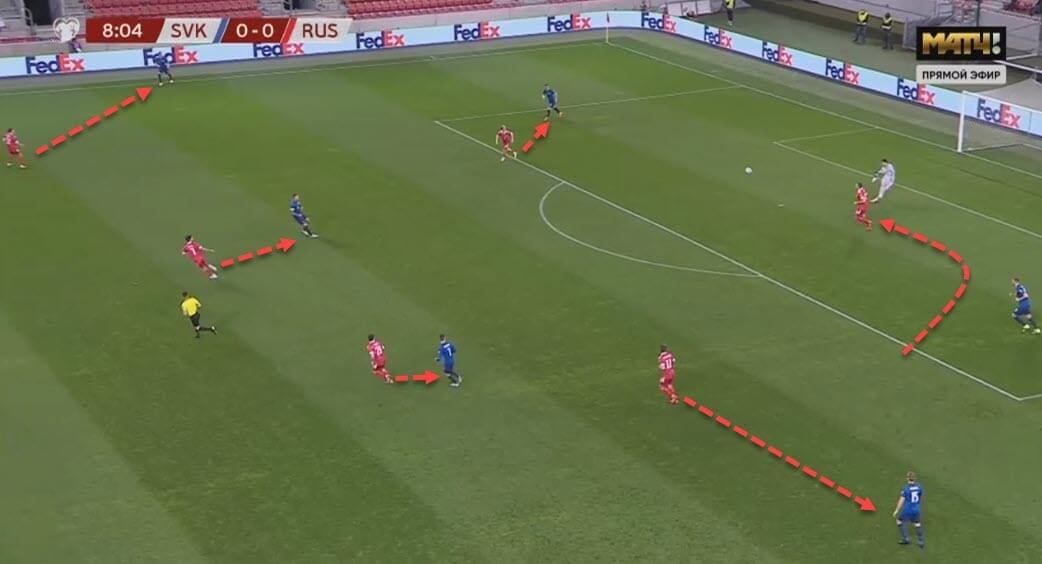
It does seem like Russia will assume a man-marking approach to their pressing tactics, trying to mimic the opposition structure to cover every short-range option when playing out of the back. This is done to either force blind clearances or mistakes in the danger areas, preferably resulting in Russia recovering possession close to the opposition goal.
In a settled defensive structure, they will assume a variation of a 4-4-1-1(2) or a 4-2-3-1, depending on the stage of their block. Given their aggressive nature, Russia will progressively raise their line, pushing up to get into the face of the opponent. We have seen Cherchesov experiment with a 3-5-2 as well, which aims to pack the middle of the pitch, trying to smother the opposition there and then start transitions towards the final third.
Generally, however, we can talk about a more standard 4-4-2 with some variations, as mentioned earlier.
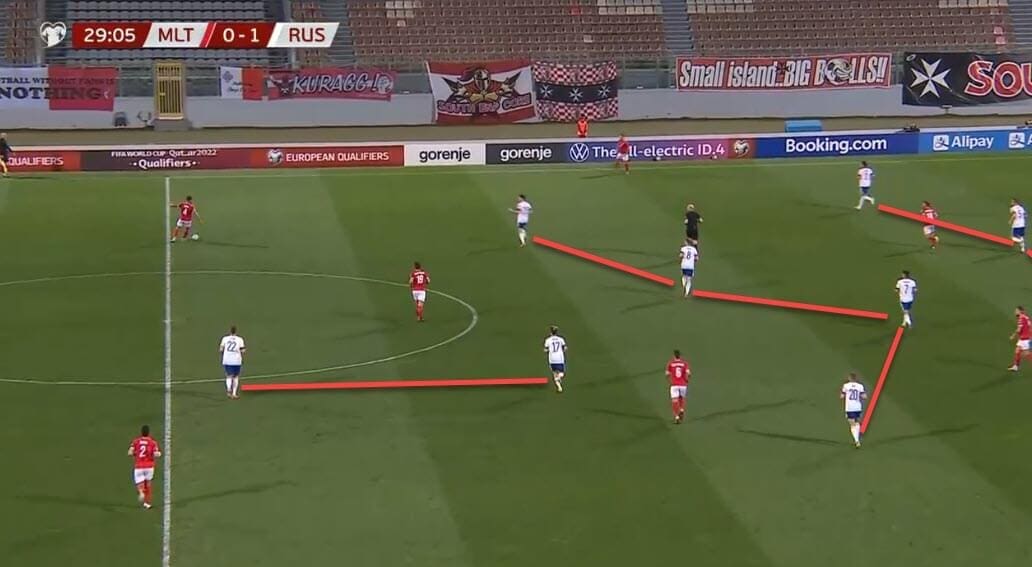
Whether they’ll be so aggressive once the tournament starts remains to be seen but as of right now, it does seem to be a part of their defensive identity. It has to be said that their approach will vary depending on the opponent. Against stronger teams that are expected to dominate both the ball and the match as a whole, we can expect a slightly deeper structure with a packed midfield and potentially even back fives in certain situations as the wide players drop into the full-back roles.
Either way, setting up their structure so that it lends itself nicely to transitional play will surely play a part in their tactics at the Euros.
TRANSITIONS
When it comes to transitional play, Russia seem very active and willing in both attacking and defensive transitions. In defence, we can often see them counter-press aggressively upon losing possession, pulling defenders out of their shape to push up the pitch and put instant pressure on the opposition ball-carrier. While that does carry a dose of risk in their play, it’s also an effective way to recover possession and turn a defensive transition into an attacking one.
Still, if the counter-press is broken, they have willing runners who will try to get back into the box despite having high starting positions. Our first example shows us the opposition during a counter-attack and Russia dropping eight players back to their half to ensure numerical superiority and defend the box easily.
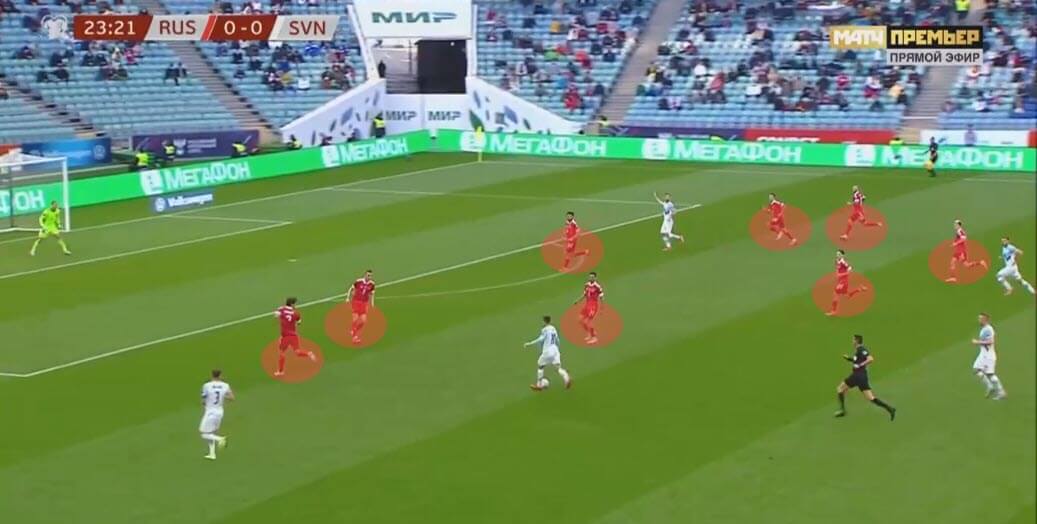
Usually, however, the likes of Dzyuba will stay higher up and Golovin, while dropping to defend as well, can stay relatively high to be the link that starts the transition should possession quickly be regained. The most interesting and impressive part of that is the work-rate and the willingness to commit to the defensive phase.
Cherchesov is often a very cautious and industrious coach and it shows in the ethic across the squad. Russia will aggressively and actively hunt for the ball in the middle and the final third, and that lends itself perfectly to attacking transitions, such as the one pictured in our next example.
Golovin is the one to tally the high recovery and start running with the ball towards the box. At the same time, we can see that Russia have three more players ready to join in immediately and one of them being Dzyuba who is the highest positioned attacker on the pitch.
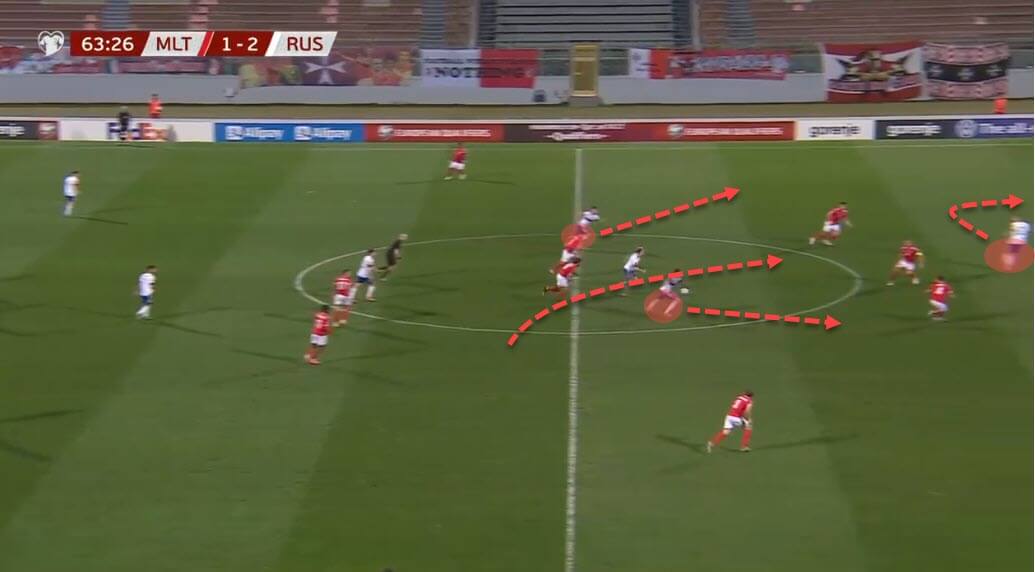
While he is initially in an offside position, that still pins the opposition backline and creates separation from the midfield line, creating more space for Russia to exploit.
FORWARDS
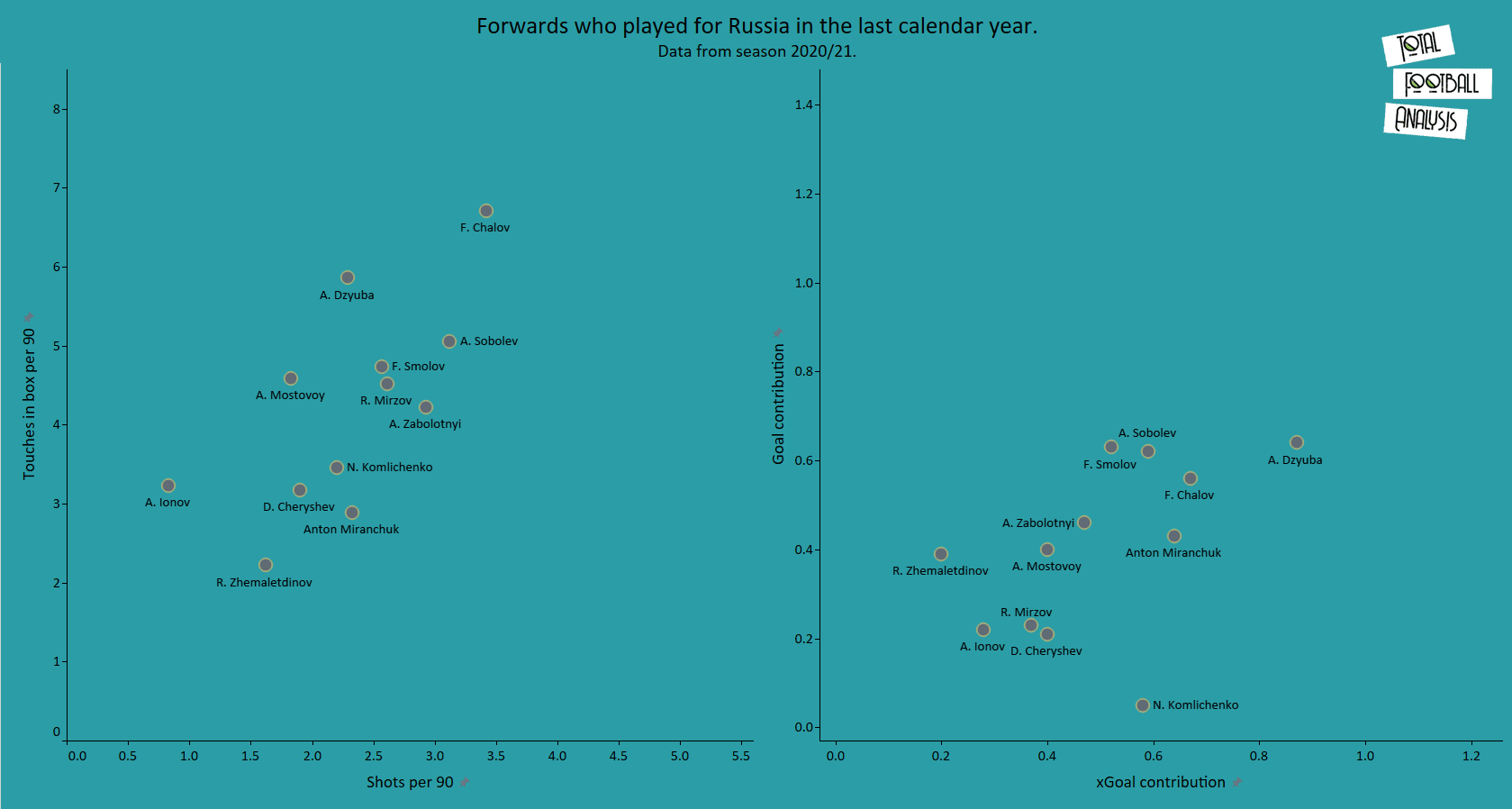
Now we’ll take a look at all of Russia’s forwards who played for the team in the last calendar year. The attackers were analysed in terms of their shot output per 90 minutes, touches in the box, goal contribution (goals + assists) and xGoal contribution (expected goals + expected assists). However, the game time is not depicted in the graphs so that has to be taken into account.
With that being said, we can see the usual suspects here with Dzyuba leading the line alongside Fyodor Chalov. The 23-year-old forward, however, hasn’t been used as much by the coach so while there is potential here, we would need a much bigger sample before making any conclusions. The same can be said for Sobolev and Smolov who are younger and could be making a big step forward in their national team careers sooner rather than later.
But as of right now, the major brunt of the attacking responsibility falls on Dzyuba’s shoulders, as was already alluded to, and continues to be both Russia’s strength and weakness. The veteran captain is topping the charts in both graphs, offering a huge presence in the box, shooting at a high rate and getting into good positions to score.
The most encouraging thing for the Russians, however, is that he often converts the chances and bags goals on a regular basis. Will that continue to be true once the Euro starts remains to be seen. We can also mention both Anton Miranchuk and Anton Zabolotny as players with decent game time and also good goal contributions.
Of course, no one is really that close to the squad captain but if they can pop off and chip in to help the team, Russia could find it much easier to wrestle with some of the stronger teams in the tournament. If they plan to solely rely on Dzyuba, they might encounter issues against more organised and defensively solid squads.
MIDFIELDERS
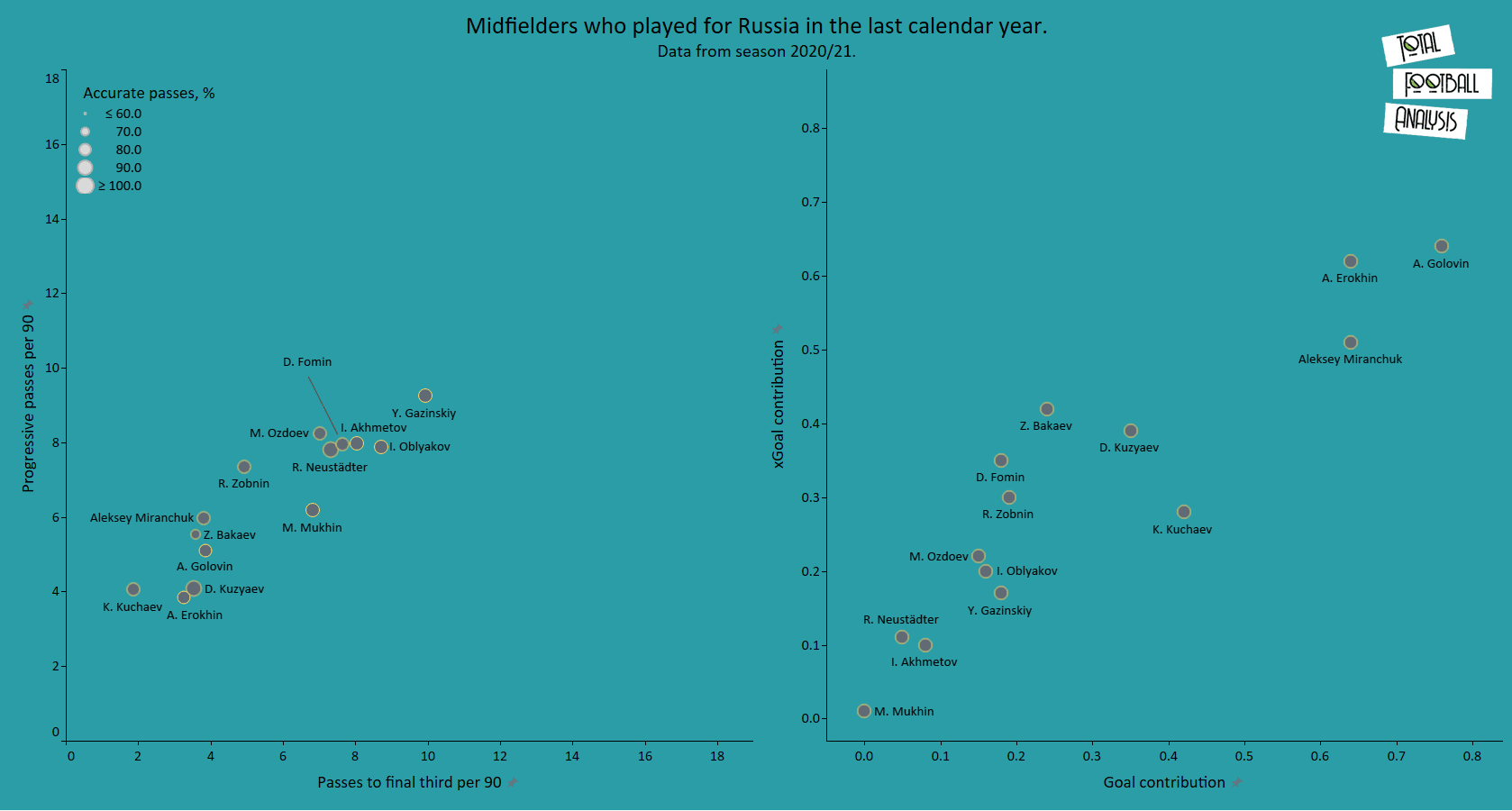
Similarly to the previous section with the forwards, Russia have some quality in midfield as well but are lacking any real depth to plug holes and help shoulder the burden of creativity and progression. When it comes to midfielders, however, we’ve decided to measure their contribution through progressiveness in their passing, passes to the final third per 90 minutes and then the same goal contribution (goals + assists) and xGoal contribution (expected goals + expected assists).
Note that the size of the circle also represents the percentage of all midfielders’ accurate passes, which will tell us which players are the most secure in possession. Instantly, in the progression chart, we see Yury Gazinsky topping the chart with both passes to final third and progressive passes per 90, indicating he’s one of the most progressive midfielders in the team. Most importantly, he’s been used quite a lot in the last calendar year by Cherchesov. With that being said and as of right now, he’s not on the list that’ll travel to the Euros.
Right behind Gazinsky we have the likes of Magomed Ozdoyev and Daniil Fomin, both of whom are invited and have had regular minutes in the last calendar year in Russia’s midfield. Looking at the direct goal contribution from the midfielders, Golovin is the player we absolutely have to highlight. As was mentioned earlier, he is the most creative of their midfielders and the one with the highest contribution rate per match.
The worrying thing, however, is the fact that apart from him, Russia don’t really have someone of that calibre who can turn games around with individual brilliance. Aleksandr Yerokhin hasn’t been regularly used in the last year while a similar thing can be said for Aleksei Miranchuk, who has the quality to make a difference if given the chance and the minutes to do so.
It will be up to the coach to pick his best pieces but the jigsaw does seem to be a quality one if put together properly.
DEFENDERS
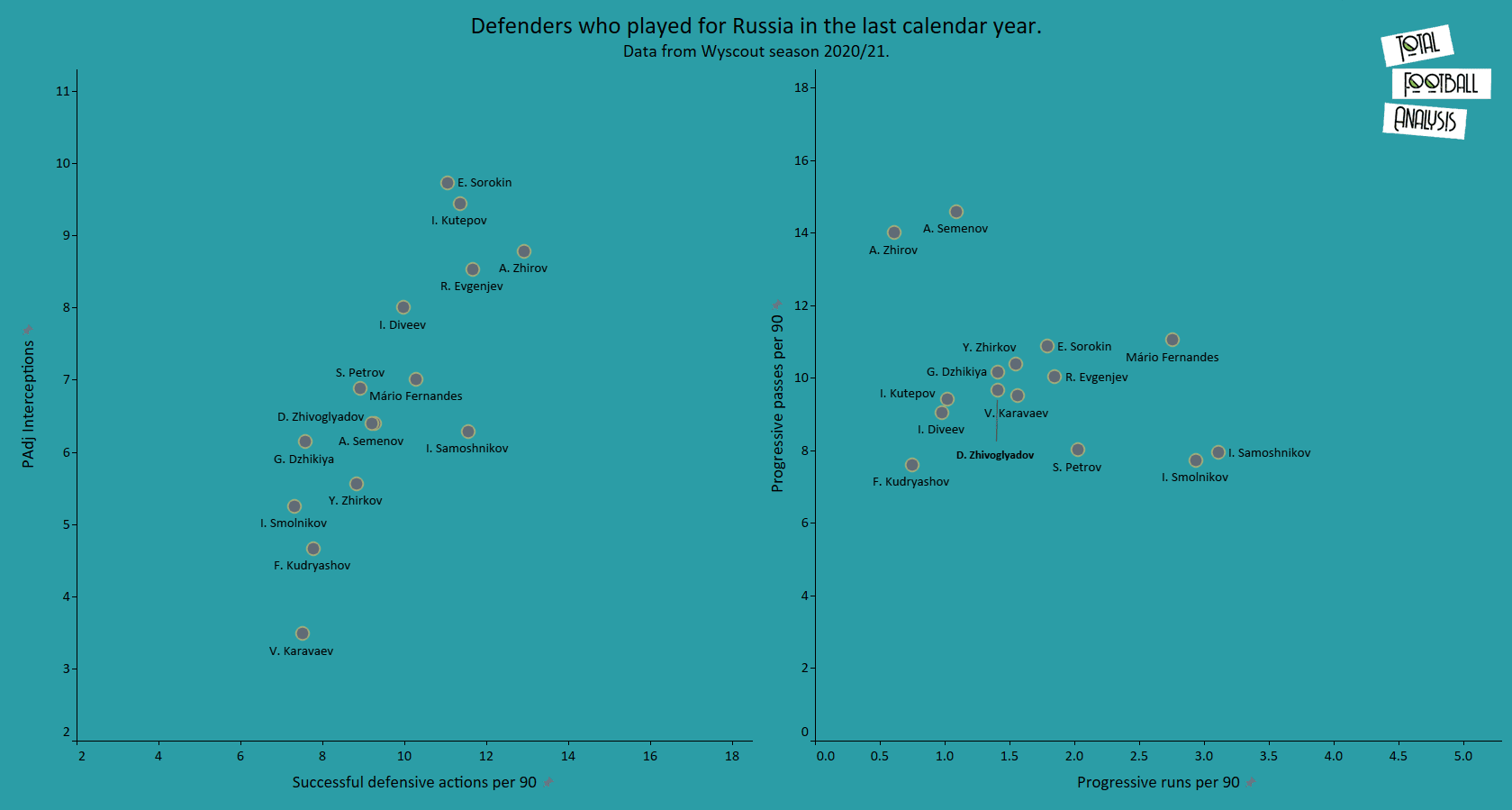
With defenders, we’ve decided to measure their overall defensive displays in terms of PAdj (possession-adjusted) interceptions and successful defensive actions per 90 and their progression through runs and passes per 90. The latter categories have become a major part of almost any team’s backlines but in Russia’s case, it proves to still be a distant concept, as per the coach’s wishes.
But starting with the defensive performances, there are a couple of stand-out players we simply have to highlight. Firstly, both Yegor Sorokin and Ilya Kutepov top the charts in interceptions and successful defensive actions but with limited game time so it has to be taken with a pinch of salt. Aleksandr Zhirov is in a very similar situation in the last calendar year but looking at Roman Evgenyev, he seems to be the most solid of the first four with a decent minute tally as well. However, as of right now, neither of those players have a cemented place in the squad for the Euros so that does represent a worry for the team as a whole.
That means that the next two in line are Sergei Petrov and Fernandes, both being reliable defenders and the latter being one of the key pieces of the overall puzzle. As already mentioned, Russia don’t rely on prolonged possession phases nor does the coach encourage playing out of the back that often.
For that reason, it doesn’t surprise to see that they don’t have that many impressive progressive passers in their team. We have already highlighted Semenov and Zhirov to be key in this regard as the two have it in their lockers to find midfielders and dropping forwards with piercing passes.
When it comes to runs, both Fernandes and Ilya Samoshnikov are great choices that can advance play and help bolster the attacking phase.
BEST PERFORMER
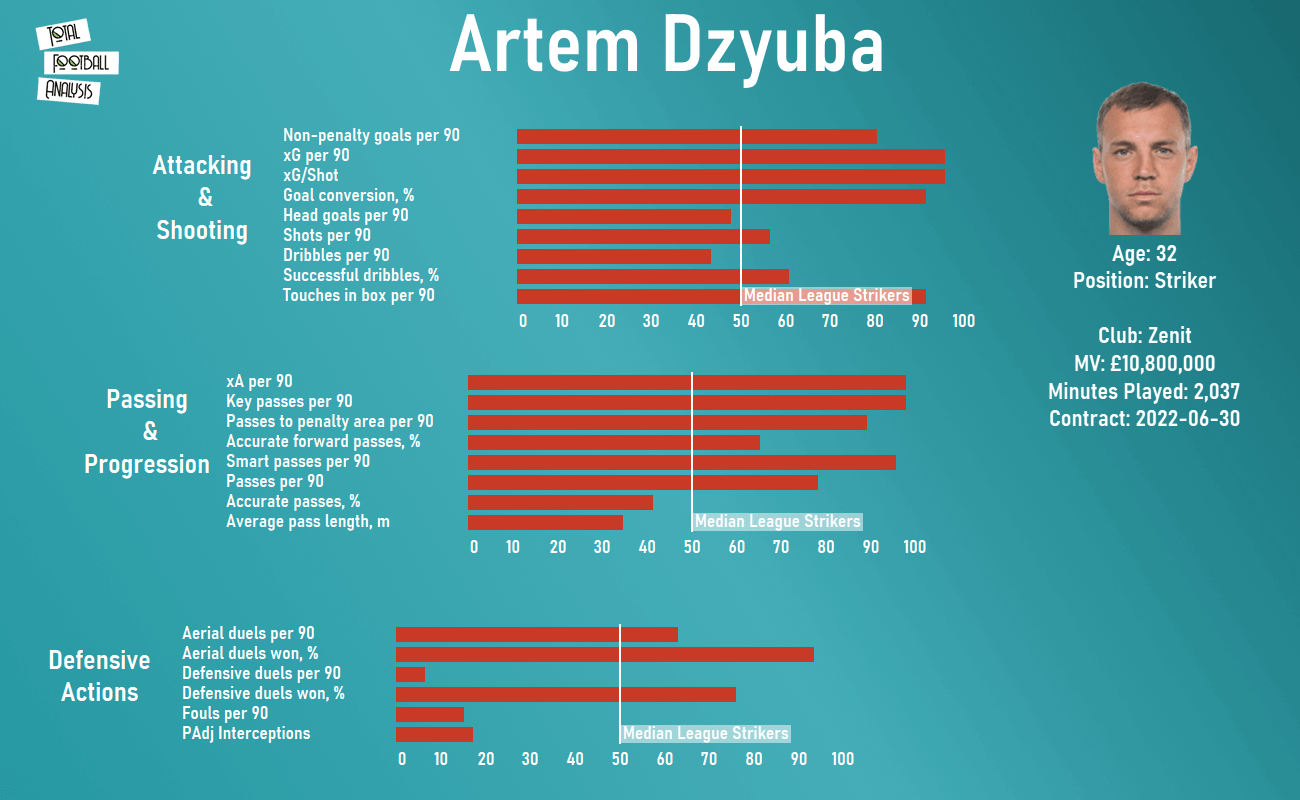
It doesn’t surprise anyone to see Artem Dzyuba as Russia’s best performer. The 32-year-old striker and captain is an enormous presence both on and off the pitch and is close to becoming the country’s leading goal-scorer. And that, again, is no surprise at all. Dzyuba’s non-penalty goals per 90 as well as his goal conversion percentage are off the charts, leading the line against other strikers in league football for Zenit.
Similarly, his xG values per 90 and xG per shot put him near the 100th percentile, which also means he’s slightly underperforming in comparison to his true output. But that doesn’t lower his value nor his poacher abilities as he’s by far Russia’s most lethal presence up front. It’s very intriguing, however, to see Dzyuba excel in other important metrics as well.
When it comes to passing and progression, the big Russian is on an elite level in creativity as well, topping the charts in xA per 90, key passes per 90 and smart passes per 90. His tendency to drop deeper to link up with the midfield is proving fruitful and his progression stats back it up.
It is, however, in the defensive categories that Dzyuba doesn’t shine as much. Of course, part of that is the fact that he likes to stay high up the pitch, offering that target man outlet as well as being the first man to apply pressure to the opposition backline. His high win rate in aerial duels explains why the role of a target man suits him perfectly while his defensive duels success should also not be disregarded despite a lower overall volume tally.
PREDICTIONS FOR THE TOURNAMENT
It is genuinely difficult to predict Russia’s fate at the upcoming EURO in this analysis. Seeing how they find themselves in the group with Belgium, Denmark and Finland, it feels like all three of those teams represent dangerous opposition for Cherchesov’s troops. Even though their qualifiers inspired a lot of confidence, the recent run of form certainly does not.
However, the team does have a lot of young talent that’s waiting to explode and maybe they will do exactly that on one of the biggest national stages of them all. Russia can no longer live on the glory of the 2018 World Cup and has to look forward to an even brighter future. If the stars align, Cherchesov could be looking at yet another successful campaign despite having the tag of an underdog.
Reaching the knockout stages could very well be tough considering the immediate opposition in the group stages but it’s also not an entirely impossible task. We’ve seen this team beat mighty opponents before and since a large part of the team remains unchanged, we’ll have to wait and see whether they have it in them to do it all once more.

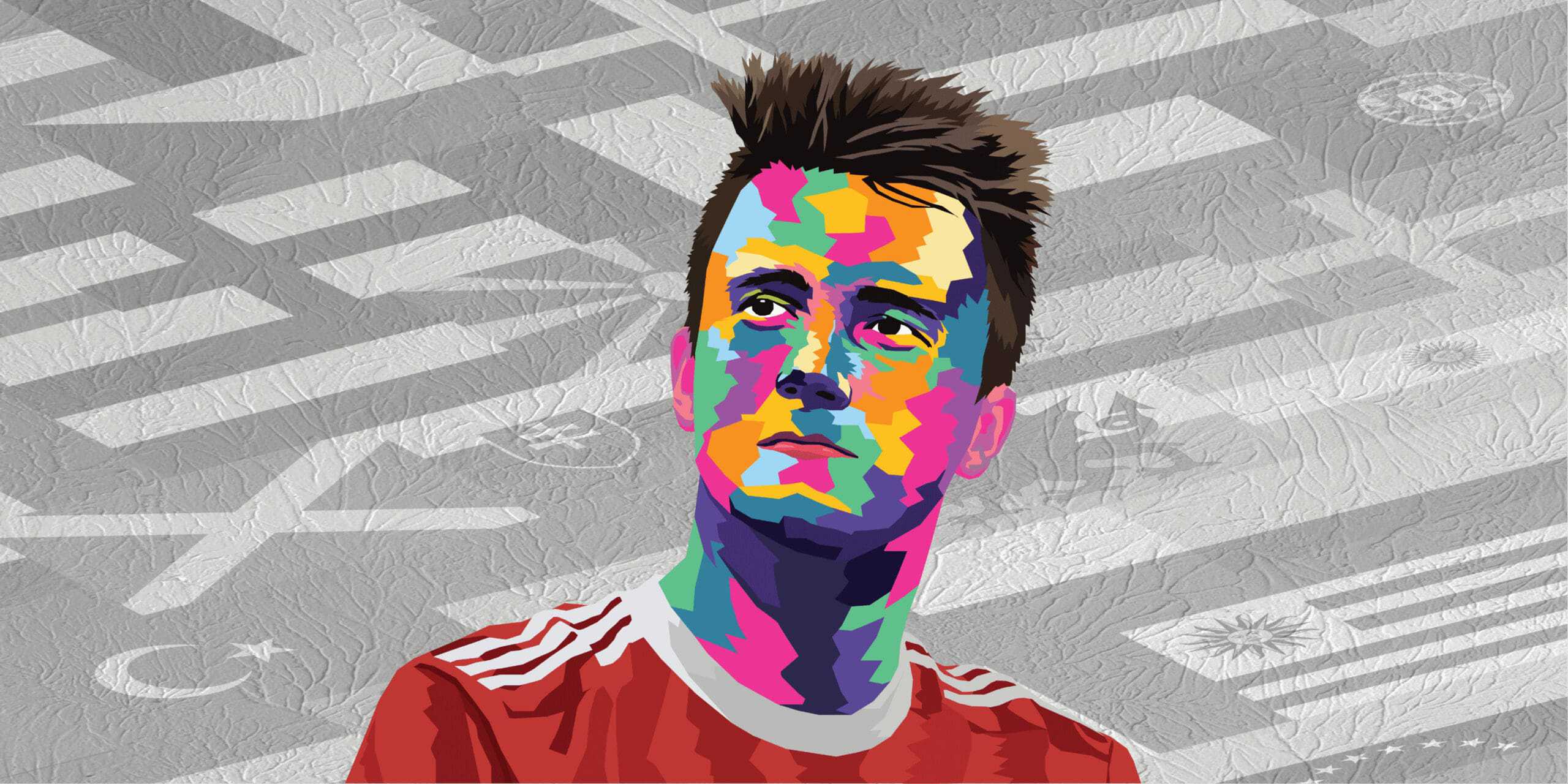




Comments